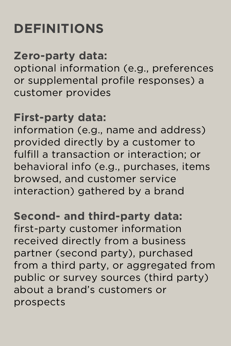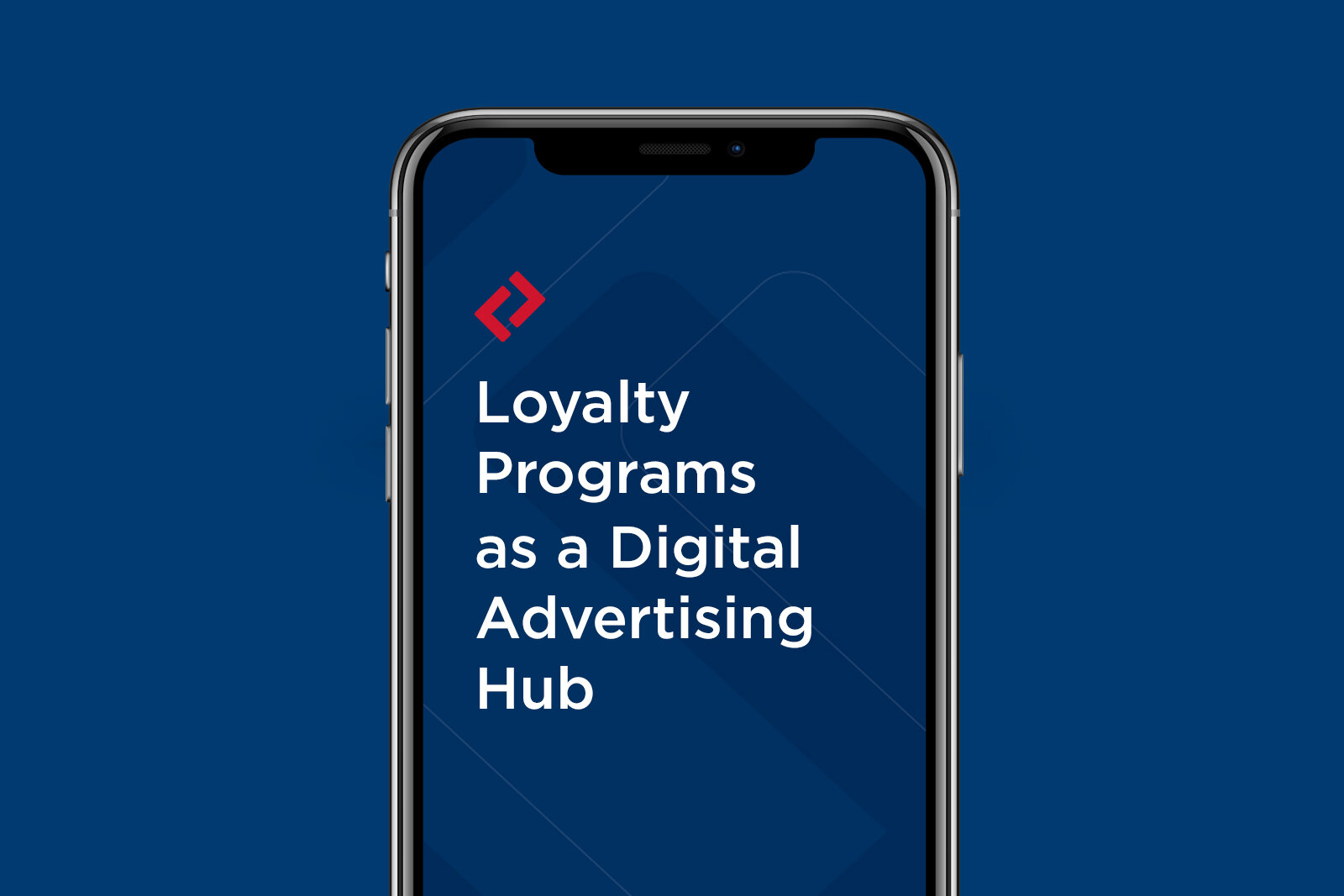Zero In on Zero-party Data to Jump-Start Customer Engagement

Zero-party data is heating up.

Google the term and you’ll find thousands of results, from simple definitions to “complete” guides, and even an article calling zero-party data the “holy grail” of consumer information. Meanwhile, research companies are cranking out reports on the topic and hosting zero-party data webinars.
It’s no wonder savvy marketers are using zero-party data to improve the personalization of their brand communications and, ultimately, to deepen their relationships with customers — a high priority these days. Even if you believe zero-party data is just a rebranding of some categories of first-party data, the distinction is useful to consider.
Defined, zero-party data is optional information customers choose to share with a brand; it may be a preference, like telling a hotel company you prefer a king-size bed and a room on a lower floor. Zero-party data can also refer to supplemental profile data, such as a product you plan to purchase. Information required to receive a product or service, e.g., a customer’s name or address, isn’t considered zero-party data; and information gathered as part of normal customer or prospect interactions (e.g., purchase or web-browsing information) isn’t either. The key to grasping zero-party data is remembering that it’s optional information customers provide to improve their experiences.
At The Lacek Group, we’ve been helping our clients better understand their customers and eliminate guesswork for a long time, and collecting zero-party data is one important strategy we use. If a brand gathers zero-party data, it no longer needs to infer a customer’s wants; she’s explicitly telling the brand what she wants. That’s a win on both sides.
Zero-party data has grown in importance during the pandemic because more of our interactions are online. According to Adobe Analytics, U.S. online holiday sales in 2020 were $188.2 billion — an increase of 32.2% year over year. If consumers trust your brand (a weighty topic best handled in a separate article), they’ll willingly share information about their wants and desires if they get better customer experiences in exchange. And isn’t that one of our primary goals as marketers — to create an exceptional and seamless customer experience?
Knowing more about your customers and prospects helps differentiate how you share marketing messages with them. Consumers wish to be seen and understood, and they want their favorite brands to recognize them across channels. Using zero-party data helps make a brand more personal.
Asking consumers for zero-party data lets brands give customers more control over the messages they receive and the customer journey they experience. If a customer shares that she wants an aisle seat and the brand provides it, that’s a positive brand and customer experience. If a customer indicates he prefers a gluten-free option and the brand follows through, that’s a positive brand and customer experience too. These brand-customer interactions fulfill a longtime goal of many marketers: to create marketing “so personalized, it feels like a service,” to borrow the words of a former colleague.
Many marketing strategies rely on customer segments or personas to identify the “right” set of messages for a particular customer. Unfortunately, sometimes it can take a high number of interactions or transactions to match a new customer with a relevant persona. Wouldn’t it be simpler, better, and faster to use zero-party data to help predict the right persona earlier in the customer engagement journey? By asking a few smart questions up front, a brand can leverage its prediction algorithms to more quickly understand a customer much earlier in a relationship.
Let’s look at four brands that successfully use zero-party data:
-
Starbucks invites customers to save their favorite customized drinks on its app; this allows these coffee lovers to order their drinks quickly from a Favorites tab.
-
Firstleaf, an online wine club, invites new customers to answer roughly a dozen questions, including how adventurous they are about trying new wines, and which foods and drinks they enjoy from a provided list. Personalized recommendations follow.
-
Like many beauty brands, Klorane, a French hair- and face-care company, invites customers to answer online questions about skin and hair concerns, and then personalizes product advice.
-
Netflix kicks off a new member’s recommendations based on favorite titles the member initially provides. Then, as the member watches Netflix, the company uses first-party data gleaned from the member’s viewing history.
Customers largely welcome targeted questions from brands, as long as the optional information they provide improves their experiences. Indeed, customers’ trust in those brands may even grow. Additionally, customers appreciate brands that maintain their data privacy, are transparent about how they’re using data, and make clear that customers are in control.
Subscription boxes are built almost completely on zero-party data. Causebox, Popsugar, Grove Collaborative, FabFitFun, and Stitch Fix, for example, all customize box contents based on each subscriber’s zero-party data. The more detailed a customer’s answers, the better a brand can fulfill her needs and the more likely a customer will feel satisfied.
Where do brands go wrong with zero-party data?
First, if a brand collects data and never uses it, that’s a miss. Let’s say a hotel asks a customer what kind of pillow he likes, and he says he’s a stickler for firm pillows. If the hotel doesn’t deliver, no doubt he’s disappointed. Or if a customer indicates a vegan meal preference to an airline, but vegan meals aren’t available on board, that’s another disappointed (and probably hangry) customer. In these cases, it would’ve been better if the customer had never been asked for preferences.
Second, if a brand requests information and then provides something altogether different, that’s a miss too. A colleague of mine and her husband, for example, were asked by their mortgage broker about the activities they most enjoy, e.g., pro sports, local theater, concerts, etc. They were told to expect a thank-you gift on their wedding anniversary. Unfortunately, they never received a gift or even a card on their anniversary. Moreover, even though they told the broker they don’t follow sports, twice a year they receive refrigerator magnets with baseball and football schedules. The key is to tell customers how you’re going to use their data, and then follow through.
Third, if a brand learns something via zero-party data about a customer, and then shares that information with other brands so the customer sees related internet ads, that’s an annoying miss. Let’s say a customer shares his preference for mint-scented soaps and lotions and is then presented with ads for other mint products (candy! tea! ice cream!) across channels. It won’t take long for the customer to figure out what happened with his data. Obviously, a brand should never sell zero-party data.
What are zero-party data best practices?
-
Don’t ask customers for information you already know or can infer based on transactional data.
-
Do ask customers for information that will help your brand personalize its messaging and deepen your customer relationships.
-
Do improve your customers’ experience — even surprise and delight them — by applying the collected zero-party data.
-
Do build customers’ trust by using zero-party data the way you promised to use it.
In a sense, requesting zero-party data turns customer privacy upside down. Instead of gathering information and then hiding how your brand plans to use it, you actually show your customers how you’ll leverage it. As cookies fall under greater scrutiny, the importance of zero-party data (and first-party data, for that matter) will only grow, change, and evolve. Marketing practices — and perhaps governmental regulations — will see to that. In the meantime, if your brand is focused on customers, it’s time to capitalize on zero-party data.
Charlie Heitzig is vice president of Data Intelligence Practice for The Lacek Group, a Minneapolis-based, data-driven, loyalty, experience and customer engagement agency that has been delivering personalization for its world-class clients for more than 30 years. The Lacek Group is an Ogilvy company.

